The downing of Ukraine International Airlines (UIA) Flight PS752 over Tehran
Flight PS 752 ! Video from take off to end based on flight data! RIP https://www.facebook.com/pezh.kayedan/videos/1712555375552795/
Before it had left the airport's air space, the plane turned around and tried to return to the runway. (Not indicated in above video)
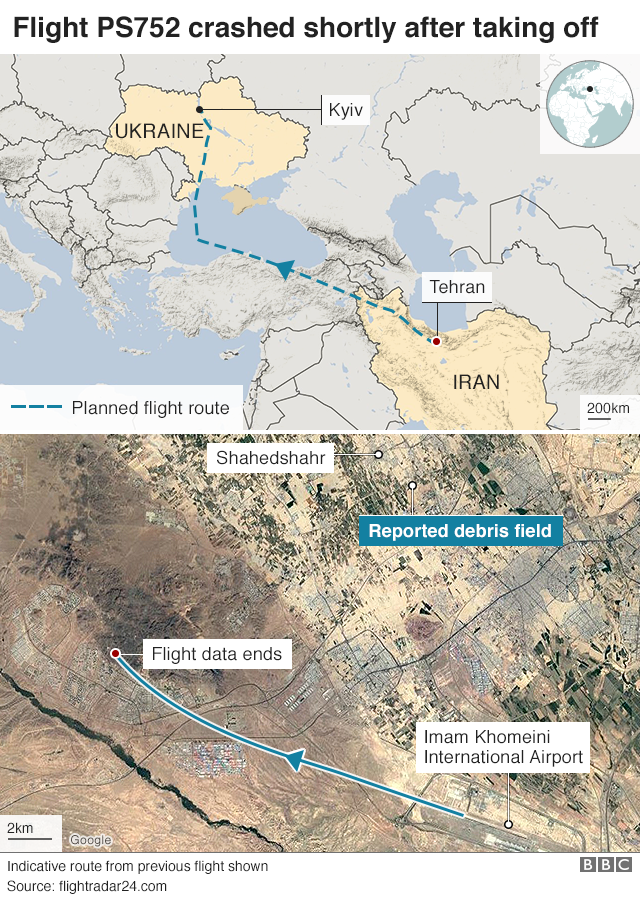
Bellingcat (!) Version: https://www.bellingcat.com/news/mena/2020/01/09/video-apparently-showing-flight-ps572-missile-strike-geolocated-to-iranian-suburb/
"evidence exists demonstrating how the flight was targeted and received damage that prompted the plane to turn back toward its point of origin before crashing northwest of the Iranian capital." https://www.washingtonpost.com/politics/2020/01/10/how-open-source-investigators-quickly-identified-irans-likely-role-crash-flight-752/
Is Bellingcat trustworthy? https://www.bellingcat.com/about/ Russian officials claimed without evidence that Bellingcat is a front for foreign intelligence services and that Bellingcat publishes falsified information.[46] Russian media have claimed that Bellingcat is funded by the U.S. government to undermine Russia and other NATO adversaries. https://en.wikipedia.org/wiki/Bellingcat
Before it had left the airport's air space, the plane turned around and tried to return to the runway. (Not indicated in above video)

Bellingcat (!) Version: https://www.bellingcat.com/news/mena/2020/01/09/video-apparently-showing-flight-ps572-missile-strike-geolocated-to-iranian-suburb/
"evidence exists demonstrating how the flight was targeted and received damage that prompted the plane to turn back toward its point of origin before crashing northwest of the Iranian capital." https://www.washingtonpost.com/politics/2020/01/10/how-open-source-investigators-quickly-identified-irans-likely-role-crash-flight-752/
Is Bellingcat trustworthy? https://www.bellingcat.com/about/ Russian officials claimed without evidence that Bellingcat is a front for foreign intelligence services and that Bellingcat publishes falsified information.[46] Russian media have claimed that Bellingcat is funded by the U.S. government to undermine Russia and other NATO adversaries. https://en.wikipedia.org/wiki/Bellingcat
N.B. NEWLY ADDED article by 'Vivian Lee' at page base which questions the whole scenario of the plane crash!
/arc-anglerfish-tgam-prod-tgam.s3.amazonaws.com/public/CBA5A452DBGZVCTC2Y4WWB4NDI.JPG)
Canada's Prime Minister Justin Trudeau attends a candle light vigil for the victims of Ukraine International Airlines flight PS-752 on Parliament Hill in Ottawa, Ontario, Canada January 9, 2020. REUTERS/Blair Gable
BLAIR GABLE/REUTERS
"Our thoughts and prayers are with the people of Canada, which has suffered such a devastating loss," the Queen said in a message to Canada's governor general today. "I extend my deepest condolences to the families, friends and colleagues of all those Canadians, and indeed other nationalities, who died, and to the many others who have been affected by this terrible event." HM The Queen.
https://www.youtube.com/watch?v=ndtDay-pdaA&t=&fbclid=IwAR215P7yu4Ie5gOgzJMbX3XYbDz_y4yWpOGOA7NLwxe272bPDefxTOIHfvQ
https://www.zinnedproject.org/news/tdih/iran-coup/?fbclid=IwAR3OngLBY_mBV3yAxzFn722WbxonexLcCHIgLY3_NOKdDE9rn_ZsUyUDE2Q
Whenever an aeroplane crashes or disappears from the sky as a result of a missile, or for any other reason, extreme caution must be applied to the conclusions drawn, particularly as it relates to any guilty or reckless act.
As regards the downing of UIA Flight PS752 at about 6:15 am (local time) on the 8th January, 2020 shortly after take-off from Tehran Airport, killing all 176 passengers and crew, it appears this resulted from a Russian-made anti-aircraft missile fired in error by Iranian forces. The Iranian Government has apparently admitted responsibility.
The Western narrative is clear: Iran is a disruptive, unethical and terrorist country, unsupported by its own people, which must be opposed, particularly in the area of becoming a nuclear power, to which the loss of the plane, its passengers and the subsequent demonstrations neatly plays. However the story and explanation for this truly tragic event, does not and should not rest there.
/arc-anglerfish-tgam-prod-tgam.s3.amazonaws.com/public/SJMX2JQ22NB2TGTZY6GLFCONFA.jpg)
/arc-anglerfish-tgam-prod-tgam.s3.amazonaws.com/public/SJMX2JQ22NB2TGTZY6GLFCONFA.jpg)
Photos of some of the victims stand among candles as members of Toronto's Iranian community attend a vigil in Toronto on Wednesday, January 8, 2020, to mourn victims of Ukraine International Airlines Flight PS752 that crashed after takeoff near Tehran, Iran.
CHRIS YOUNG/THE CANADIAN PRESS
The three following disparate articles make valid and relevant points.
The first from Russian sources, suggests that in several respects it replicates the destruction of a Russian IL-20 in Latakia, Syria in September 2018, in which US military aircraft used a civil one to hide behind and which thus fell victim to a missile. By all accounts foreign (US?) military planes were observed in the region at the time, when the Iranians were in a high state of readiness expecting attacks. Was the Latakia technique employed again to the same purpose?
The second article from a Canadian source, reminds everyone, that were it not for President Trump's preemptive missile assassination of Iranian General Qasem Soleimani, the firing of Iranian missiles would not have occurred, either intentionally or mistakenly. That therefore part of the blame for the crash of PS752 must rest with the American aggression in Iraq.
The third article from an American source, reminds us that America under Trump and previous administrations, has pursued a long-term aggressive policy of economic warfare against Iran with all the predictable consequences that entails, namely economic instability and public unrest. Iran is justifiably ill at ease and in a defensive posture. It has every reason to be so given the threats emanating from the White House and Congress. There is little doubt in this, America is following an Israeli/Saudi agenda that seeks war with Iran and America to pursue it on their behalf.
But in addition to these very valid positions it is also worth noting that this particular crash is but the most recent of a number in analogous circumstances, each of which raises some intriguing questions. Such is the advanced state of computer technology, it now becomes feasible to control systems remotely both in aircraft and weapons. (See: https://en.wikipedia.org/wiki/Boeing_Honeywell_Uninterruptible_Autopilot )
We can no longer rule out this possibility or indeed of other subversive interventions carried out in such a way as to place the blame elsewhere. Aircraft manufactured by the Boeing Corporation of America appear to have the habit of figuring in these strange incidents. (Non fatal accidents involving engine fires of failure of other systems such as landing gear, are not included.) Source:
It should be noted that the IL-20 crash is not included in the following list as it was a military aircraft not a commercial one.
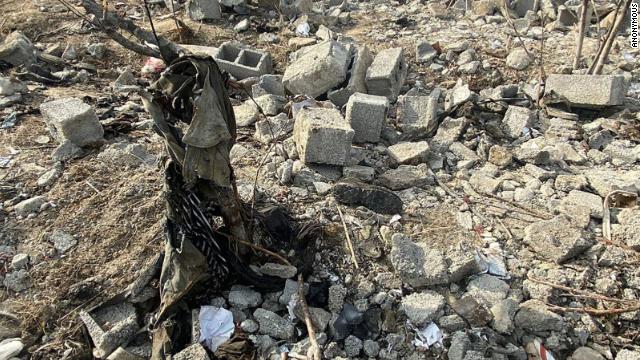
https://edition.cnn.com/middleeast/live-news/us-iran-news-01-11-2020-intl/index.html
The assassination of Soleimani, is of course only the latest of numerous assassinations of Iranian scientists, usually carried out by Israeli Mossad agents (See: https://en.wikipedia.org/wiki/Assassination_of_Iranian_nuclear_scientists) and other highly subversive activities such as the 'Stuxnet' programme that wrecked nuclear centrifuges and caused widespread computer damage elsewhere (See: https://en.wikipedia.org/wiki/Stuxnet)
So to assume that similar operations could not be contrived to bring down a passenger plane would be naive.
America has a previous record of doing so, when for no strategic reason, it intentionally shot down Iran Air Flight 655 in 1988, for which it has never apologised (See: https://en.wikipedia.org/wiki/Iran_Air_Flight_655)
In similar vein the deliberate attack by Israel of the USS Liberty in 1967, killing 34 and injuring hundreds more, was subject to a major cover-up by both America and Israel to allegedly protect the reputations of both and preserve the alliance. (See: https://en.wikipedia.org/wiki/USS_Liberty_incident)
All these factors combine to suggest that there is western agreement to use covert commercial and military activity, designed to destroy the Iranian regime, as it has in at least three other Middle Eastern nations, using resultant events as powerful propaganda, painting it in an unfavourable light.
The context should make us very wary of the one-sided arguments coming out of Washington, Jerusalem, Riyadh and European capitals, that conveniently disguise malign intent within a blanket of concern for western liberal and democratic values.
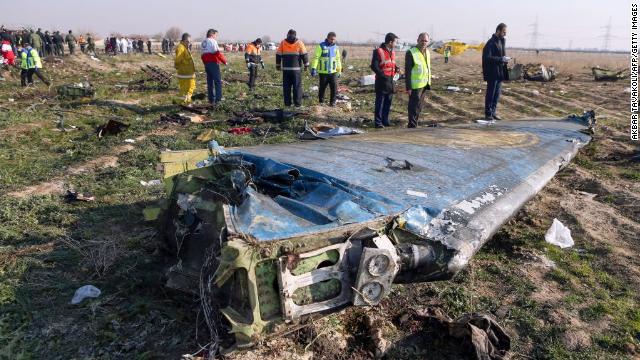

https://edition.cnn.com/middleeast/live-news/us-iran-news-01-11-2020-intl/index.html
The assassination of Soleimani, is of course only the latest of numerous assassinations of Iranian scientists, usually carried out by Israeli Mossad agents (See: https://en.wikipedia.org/wiki/Assassination_of_Iranian_nuclear_scientists) and other highly subversive activities such as the 'Stuxnet' programme that wrecked nuclear centrifuges and caused widespread computer damage elsewhere (See: https://en.wikipedia.org/wiki/Stuxnet)
So to assume that similar operations could not be contrived to bring down a passenger plane would be naive.
America has a previous record of doing so, when for no strategic reason, it intentionally shot down Iran Air Flight 655 in 1988, for which it has never apologised (See: https://en.wikipedia.org/wiki/Iran_Air_Flight_655)
In similar vein the deliberate attack by Israel of the USS Liberty in 1967, killing 34 and injuring hundreds more, was subject to a major cover-up by both America and Israel to allegedly protect the reputations of both and preserve the alliance. (See: https://en.wikipedia.org/wiki/USS_Liberty_incident)
All these factors combine to suggest that there is western agreement to use covert commercial and military activity, designed to destroy the Iranian regime, as it has in at least three other Middle Eastern nations, using resultant events as powerful propaganda, painting it in an unfavourable light.
The context should make us very wary of the one-sided arguments coming out of Washington, Jerusalem, Riyadh and European capitals, that conveniently disguise malign intent within a blanket of concern for western liberal and democratic values.

2020
Jan 8 UIA 752 Boeing 737 800 Take off from Iran International Airport. Iranian missile strike in error.
2019
March 10 – Ethiopian Airlines Flight 302, a Boeing 737 MAX 8, crashes near Bishoftu, Ethiopia six minutes after taking off from Bole International Airport; all 149 passengers and eight crew are killed.
January 14 – 2019 Saha Airlines Boeing 707 crash, a Boeing 707-3J9C overshoots the runway on landing by mistake at Fath Air Base, Iran, killing 15 of 16 people on board.
2018
October 29 – Lion Air Flight 610, a Boeing 737 MAX 8, crashes into the Java Sea shortly after takeoff from Soekarno–Hatta International Airport in Jakarta en route to Depati Amir Airport in Pangkal Pinang, Indonesia. All 181 passengers and eight crew are killed.
September 28 – Air Niugini Flight 73, a Boeing 737-800, lands short of the runway and comes to rest in a lagoon at Chuuk International Airport in the Federated States of Micronesia, one passenger dies whilst 34 passengers and 12 crew escape without serious injuries.
September 1 – Utair Flight 579, a Boeing 737-800, overshoots the runway and catches fire while landing in Sochi International Airport, injuring 18 people. One airport employee dies of a heart attack.
August 16 – Xiamen Airlines Flight 8667, a Boeing 737-800, crash-lands at Ninoy Aquino International Airport amidst heavy monsoon rains while landing runway 06/24. The aircraft skids off the end of the runway. All 157 passengers and eight crew are unharmed.J
July 31 – Aeroméxico Connect Flight 2431, an Embraer ERJ-190AR, crashes into wooded terrain in Durango shortly after take-off from Durango International Airport. The aircraft is destroyed, but all 99 passengers and four crew survive.
August 4 – A Ju-Air Junkers Ju 52 crashes near Piz Segnas, Switzerland, killing all 20 on board.
May 18 – Cubana de Aviación Flight 972, a Boeing 737-200/Adv, crashes shortly after takeoff from José Martí International Airport in Havana, Cuba. 112 of the 113 passengers and crew are killed; the sole survivor is seriously injured.
April 17 – Southwest Airlines Flight 1380, a Boeing 737-700 en route over Bernville, Pennsylvania, suffers an engine failure at cruise altitude. Some debris enters the fuselage, causing substantial damage to the aircraft and loss of cabin pressure. The crew safely diverts to Philadelphia International Airport. One passenger is killed; another seven are injured.
February 11 – Saratov Airlines Flight 703, an Antonov An-148, crashes shortly after taking off from Domodedovo International Airport, Russia. All 71 passengers and crew are killed.
February 18 – Iran Aseman Airlines Flight 3704, an ATR 72-200 on a domestic flight in Iran, crashes into the Zagros Mountains killing all 60 passengers and six crew members on board.
March 11 – A Bombardier Challenger 604 private jet crashes in the Zagros Mountains, Iran, killing all 11 people on board.
March 12 – US-Bangla Airlines Flight 211, a Bombardier Q400 on an international flight from Dhaka to Nepal, crashes at Tribhuvan International Airport; 52 of the 71 people on board are killed.
February 18 – Iran Aseman Airlines Flight 3704, an ATR 72-200 on a domestic flight in Iran, crashes into the Zagros Mountains killing all 60 passengers and six crew members on board.
March 11 – A Bombardier Challenger 604 private jet crashes in the Zagros Mountains, Iran, killing all 11 people on board.
March 12 – US-Bangla Airlines Flight 211, a Bombardier Q400 on an international flight from Dhaka to Nepal, crashes at Tribhuvan International Airport; 52 of the 71 people on board are killed.
2017
January 16 – Turkish Airlines Flight 6491, a Boeing 747-400F, crashes into a residential area upon attempting landing in thick fog in Bishkek, Kyrgyzstan. The four crew members and 35 people on the ground are killed.
2016
November 28 – LaMia Airlines Flight 2933, an Avro RJ85, crashes at Cerro Gordo en route to Medellín, Colombia. It was carrying the Brazilian football team Chapecoense. Only six survive among 77 passengers and crew.
May 19 – EgyptAir Flight 804, an Airbus A320, crashes into the eastern Mediterranean Sea after a series of sharp descending turns. All 56 passengers and 10 crew are killed.
April 29 – In the 2016 Turøy helicopter crash, a Eurocopter EC225L Super Puma helicopter crashes near Turøy, an island off the coast of Norway. All 13 passengers and crew are killed.
March 19 – Flydubai Flight 981, a Boeing 737-800, crashes while landing at Rostov-on-Don, Russia, in poor weather. All 62 people on board are killed.
February 2 – Daallo Airlines Flight 159, an Airbus A321, suffers an explosion shortly after taking off from Aden Adde International Airport, Somalia. Two people are injured and one, the suspected suicide bomber, is killed after falling from the aircraft.
January 8 – West Air Sweden Flight 294, a Bombardier CRJ200 cargo freighter, crashes while in cruise near Akkajaure in Sweden. Both crew members on board are killed.
January 8 – West Air Sweden Flight 294, a Bombardier CRJ200 cargo freighter, crashes while in cruise near Akkajaure in Sweden. Both crew members on board are killed.
2015
November 4 – In the 2015 Juba An-12 crash, an Allied Services, Ltd. Antonov An-12 crashes near the White Nile shortly after takeoff from Juba International Airport, killing 37 of 39 on board
October 31 – Metrojet Flight 9268, an Airbus A321, explodes in mid-air over the Sinai Peninsula due to a terrorist bomb, 23 minutes after takeoff from Sharm-El-Sheikh, killing all 224 passengers and crew on board.
September 5 – Ceiba Intercontinental Airlines Flight 71, a Boeing 737-800, collides in a mid-air with a BAe 125 air ambulance operated by Senegalair over eastern Senegal. The BAe 125 crashes in the Atlantic killing all seven on board, while the 737 lands safely without any injuries to those on board.
August 16 – Trigana Air Service Flight 267, an ATR-42, crashes while en route from Sentani Airport, to Oskibil Airport in the eastern Indonesian province of Papua. All 49 passengers and five crew members are killed in the crash in the worst aviation accident ever involving the ATR-42.
March 24 – Germanwings Flight 9525, an Airbus A320, crashes in southern France en route from Barcelona, Spain to Düsseldorf, Germany as a result of a deliberate act by the first officer. All 144 passengers and six crew on board the aircraft die in the crash.
February 4 – TransAsia Airways Flight 235, an ATR-72, stalls on takeoff and crashes into the Keelung River in Taiwan after striking the Huandong Viaduct and a passing taxi. 43 of the 58 passengers and crew on board are killed.
2014
December 28 – Indonesia AirAsia Flight 8501, an Airbus A320 en route from Surabaya, Indonesia to Singapore, crashes into waters off Borneo, killing all 155 passengers and seven crew on board.
August 10 – Sepahan Airlines Flight 5915, a HESA IrAn-140 (an Antonov An-140 built under license) crashes shortly after takeoff from Mehrabad International Airport, Iran, killing 39 of the 48 people on board.
July 24 – Air Algérie Flight 5017, a chartered Swiftair McDonnell Douglas MD-83 operating for Air Algérie en route from Burkina Faso to Algiers, crashes in the northern Mali desert after disappearing from radar approximately 50 minutes after takeoff, killing all 110 passengers and six crew members on board.
July 23 – TransAsia Airways Flight 222, an ATR-72 en route from Kaohsiung to Penghu, Taiwan, crashes during go-around, killing 48 of the 58 people on board.
July 17 – Malaysia Airlines Flight 17, a Boeing 777 en route from Amsterdam to Kuala Lumpur, is shot down over eastern Ukraine, killing all 283 passengers and 15 crew on board in the deadliest civilian airliner shootdown incident.
March 8 – Malaysia Airlines Flight 370, a Boeing 777 en route from Kuala Lumpur to Beijing with 227 passengers and 12 crew on board, disappears from radar over the Gulf of Thailand. A wing part was later found in Réunion.
2013
November 29 – LAM Mozambique Airlines Flight 470, an Embraer 190, en route from Maputo International Airport, Mozambique, to Quatro de Fevereiro Airport, Angola crashes into Bwabwata National Park in northern Namibia, killing all 33 people on board.
November 17 – Tatarstan Airlines Flight 363, a Boeing 737, crashes at Kazan International Airport, Russia, during a go-around, killing all 50 people on board.
October 16 – Lao Airlines Flight 301, an ATR-72, crashes shortly before landing at Pakse International Airport under adverse weather conditions, killing all 44 passengers and five crew on board.
October 3 – Associated Aviation Flight 361, an Embraer 120, crashes shortly after takeoff from Murtala Muhammed International Airport, Lagos, killing 15 people on board.
July 6 – Asiana Airlines Flight 214, a Boeing 777, crashes short of the runway on landing at San Francisco International Airport, killing three of 307 on board and injuring 182. The crash was the first fatal accident involving the Boeing 777.
July 7 – A de Havilland Canada DHC-3 operated by Rediske Air crashes on approach to Soldotna Airport, Alaska, killing all 10 people on board.
July 7 – A de Havilland Canada DHC-3 operated by Rediske Air crashes on approach to Soldotna Airport, Alaska, killing all 10 people on board.
April 29 – National Airlines Flight 102, a Boeing 747 freighter, stalls and crashes shortly after takeoff from Bagram Airfield, Afghanistan, due to load shifting, killing all seven crew members on board.
January 29 – SCAT Airlines Flight 760, a Bombardier CRJ200, crashes in thick fog on approach to Almaty International Airport, Kazakhstan, killing all 16 passengers and five crew on board.
2012
June 3 – Dana Air Flight 992, a McDonnell Douglas MD-83 carrying 147 passengers and six crew members crashes in a suburb of Lagos, Nigeria, on approach to Murtala Muhammed International Airport, killing all on board and 10 more people on the ground.
June 29 – Six people attempt to hijack Tianjin Airlines Flight 7554, an Embraer E-190, 10 minutes after takeoff; passengers and crew are able to restrain the hijackers until the aircraft makes an emergency landing; of the 101 on board, two hijackers die and 11 passengers and crew are injured; this is China's first serious hijacking attempt since 1990.
June 29 – Six people attempt to hijack Tianjin Airlines Flight 7554, an Embraer E-190, 10 minutes after takeoff; passengers and crew are able to restrain the hijackers until the aircraft makes an emergency landing; of the 101 on board, two hijackers die and 11 passengers and crew are injured; this is China's first serious hijacking attempt since 1990.
April 2 – UTair Flight 120, an ATR-72, crashes shortly after takeoff from Roshchino International Airport, Tyumen, Russia, killing 31 of the 43 passengers and crew on board.
April 20 – Bhoja Air Flight 213, a Boeing 737, crashes near Chaklala airbase, Rawalpindi, Pakistan, in bad weather, killing all 127 people on board.
May 9 – In the Mount Salak Sukhoi Superjet 100 crash, a Sukhoi Superjet 100 crashes into Mount Salak, Indonesia, on an exhibition flight, killing all 45 passengers and crew on board.
April 20 – Bhoja Air Flight 213, a Boeing 737, crashes near Chaklala airbase, Rawalpindi, Pakistan, in bad weather, killing all 127 people on board.
May 9 – In the Mount Salak Sukhoi Superjet 100 crash, a Sukhoi Superjet 100 crashes into Mount Salak, Indonesia, on an exhibition flight, killing all 45 passengers and crew on board.
According to Russian Experts: The US Bears “Partial Responsibility” for the “Human Error” Which Caused the Ukrainian plane crash
According to Russian Experts: The US Bears “Partial Responsibility” for the “Human Error” Which Caused the Ukrainian plane crash
By Corriere PT
Global Research, January 12, 2020
Url of this article:
A Russian military site Avia.pro has addressed the issue of “human error” relating to the crash of Ukraine’s Boeing 737 [departing from Tehran] on January 8, minutes after takeoff, which resulted in the death of 179 passengers and members of the crew.
Relying on military experts, the report intimates that the incident bears a canny (point by point) resemblance to the destruction of a Russian IL-20 in Latakia, Syria in September 2018.
Israeli fighters, followed by Syrian missiles, used the Russian plane as a shield, even if it meant its destruction and the death of 15 passengers.
The Russian military website refers to an independent investigation that concluded the US is “at least partial US responsibility” in the January 8 tragedy:
“According to experts, the US military had deliberately changed the information on the Ukrainian Boeing 737 flight, making it a real target for the Iranian air defense systems.”
According to data from Pentagon-related sources, several U.S. military planes were observed in the sky in the vicinity of Iran’s airspace, just at the time of the Boeing’s flight departure.
Anomalies were observed on Iran’s radar system, probably due to a cyber attack.
The civilian plane was therefore confused with a fighter plane heading directly for a military target.
“Since the pilot made a U-turn, it is very likely that the US cyber attack had also focused on the navigation system of the Ukrainian Boeing. This is not the first time that Americans have done this type of action, ” said Avia.pro.
In addition, a member of the Security and Defense Committee of the Russian Duma accused the provocative US measures against Iran of having been the cause of the Ukrainian plane crash.
Original article Corriere PL (Italian) Translation by Global Research
Following from: https://edition.cnn.com/2020/01/13/business/maple-leaf-foods-ceo-ukraine-plane-intl-hnk/index.html
Canadian CEO says the United States shares blame for Iran plane crash
Updated 1045 GMT (1845 HKT) January 13, 2020
Hong Kong (CNN Business)The CEO of a Canadian company affected by last week's plane crash near Tehran has lashed out against the Trump administration's handling of the crisis in relations between the United States and Iran.
Michael McCain, chief executive of Canadian food packaging company Maple Leaf Foods (MLFNF), said one of his colleagues lost his wife and 11-year-old son after Iranian forces shot down the Ukrainian Airlines jet Wednesday, killing all 176 people on board.
McCain said Sunday night in a series of tweets posted on his company's verified Twitter account that he believes President Donald Trump's actions in the Middle East were ultimately responsible for their deaths, describing them as "the collateral damage" of an "ill-conceived plan to divert attention from political woes."
The flight crashed shortly after taking off from Tehran's airport. Iran has said that it mistakenly shot down the plane just a few hours after it fired missiles at Iraqi military bases housing US troops. The attacks on those bases came in retaliation for a US drone strike at Baghdad's airport, which killed top Iranian commander Qasem Soleimani.
Fifty-seven Canadians were killed in the crash. The victims also included 82 Iranians, 11 Ukrainians, 10 Swedes, four Afghans, three Germans and three British nationals.
"I am very angry, and time isn't making me less angry," McCain wrote, calling the recent incidents in Iran "a needless, irresponsible series of events."
"Canadians needlessly lost their lives in the crossfire, including the family of one of my MLF colleagues (his wife + 11 year old son)! " he wrote. "We are mourning and I am livid."
Despite having a modest presence on Twitter — the company's account has just over 2,400 followers — the comments stoked immediate reaction online. Around 2 a.m. Eastern Time on Monday, McCain's initial tweet had been liked about 27,000 times and retweeted 8,500 times. His additional tweets also received thousands of likes, retweets and replies.
Some social media users responded with words of support, including one person who said McCain's response "shows how much [of] an impact" the event is having on Canadians "from all walks of life."
Others, though, responded with calls to boycott the company.
"Fantastic exercise in branding," one user wrote. "Currently looking up all products produced by MLF and not going to purchase a single one from now on. It is one thing to express your personal beliefs on your own page but to do so using your companies [sic] Twitter page with logo is corporate suicide!"
Maple Leaf Foods did not immediately respond to a request for comment outside regular business hours.
The company is based in Mississauga, Ontario and employs about 12,500 people, according to its website. It produces meat and deli products, and is listed on the Toronto Stock Exchange.
Trump has just signed an executive order imposing EVEN MORE SANCTIONS ON IRAN. He and his warmongering cronies—Pompeo, Mnuchin, Hook—claim that Iran is the cause of the current state of the destabilized Middle East. But people all around the world know that it was the US invasion of Iraq that unleashed waves of violence and created ISIS, and it was Trump’s withdrawal from the nuclear deal that created the crisis with Iran.
It is up to us to make sure our voices for a sustainable peace between the US and Iran are heard. Add your name to our open letter to the people of Iran apologizing for Trump’ actions to provoke a war and condemning his “maximum pressure” campaign of brutal sanctions (aka economic warfare).
Even though an all-out war didn’t break out between the U.S. and Iran last weekend, the crisis is far from over. Trump and his war-loving cronies are continuing to escalate with hateful threats and new forms of aggression. On Friday, Pompeo announced EVEN MORE sanctions, shamefully bragging that the U.S. is preventing Iran from accessing 90% of its overseas funds.
But we have a plan: We are bringing our call for peace and de-escalation directly inside Iran to show their people that ordinary Americans are declaring that Donald Trump does NOT represent us. Rather than war, we want PEACE and we know that in order to achieve peace, the brutal sanctions on Iran must be lifted. Sign our open letter below and share it widely. We will publish it in Iran and blast it all over social media on January 25, the International No War WIth Iran Day of Action.
Dear people of Iran,
We, the American people, are horrified by the actions of our government to provoke a war with you. From President Trump’s dangerous decision to pull out of the Iran nuclear agreement, to the crippling sanctions his administration has imposed, to the assassination of General Qasem Soleimani—President Trump and his administration have pushed our two nations to the brink of war.
Unlike our president, we do not want to provoke a war with your country—we want to live in peace and harmony with the people of Iran. We pledge to do everything in our power to stop the U.S. from carrying out further attacks on Iran and to end the brutal sanctions which have already caused immense suffering to millions of ordinary Iranian citizens.
Please accept our hand in friendship. May the peacemakers prevail over those who sow hatred and discord.
Sincerely,
Click to add your name to the letter!
We, the American people, are horrified by the actions of our government to provoke a war with you. From President Trump’s dangerous decision to pull out of the Iran nuclear agreement, to the crippling sanctions his administration has imposed, to the assassination of General Qasem Soleimani—President Trump and his administration have pushed our two nations to the brink of war.
Unlike our president, we do not want to provoke a war with your country—we want to live in peace and harmony with the people of Iran. We pledge to do everything in our power to stop the U.S. from carrying out further attacks on Iran and to end the brutal sanctions which have already caused immense suffering to millions of ordinary Iranian citizens.
Please accept our hand in friendship. May the peacemakers prevail over those who sow hatred and discord.
Sincerely,
Click to add your name to the letter!
Last week the House voted for and passed a war powers resolution stating that without Congressional approval, Trump cannot carry out a military strike on Iran. The Senate will vote on a companion resolution soon, but even though this is a necessary first step, it is far from enough. As Trump beats the drums of war, our voices are crucially needed to show to the people of Iran—and the world—our desires for peace!
Every Iranian citizen who hears Trump’s hateful rhetoric must also hear from us. While Trump, Mike Pompeo, Brian Hook, and others are demanding Iran “behave like a normal nation,” they are continuing to support and sell arms to the terrorist country of Saudi Arabia, a country that has created the largest humanitarian crisis on the planet in Yemen. What hypocrisy!
Add your name to CODEPINK’s open letter, and choose 10 friends to share it with. Make our message of peace impossible to ignore!
The following from: https://lightonconspiracies.com/vivian-lee-the-strange-crash-of-ukrainian-flight-752-in-iran/ Posted here at 11.55 BST on the 16th Jan., 2020
Vivian Lee, The Strange Crash of Ukrainian Flight #752 in Iran
Vivian Lee
On the morning of January 8, 2020, a Boeing 737 crashed and left debris scattered over a wide area just minutes after takeoff from the Imam Khomeini International Airport in Tehran. The Ukrainian International Airlines jet was en route to Kyiv, scheduled to land at Boryspil International Airport at 8 am local time. “Amateur” videos posted on social media led to the suspicion that the plane had been brought down by a missile over the city of Parand.
The first video, posted on Instagram by The Rich Kids of Tehran, was taken by someone who just happened to be shooting up at the totally dark sky at the very moment the plane appeared and was apparently hit by something, resulting in its crash in a flaming fireball when it hit the ground. This recalls the luck of the Naudet brothers on 9/11. The New York Times obtained a high-resolution copy of the Rich Kids video and “verified” it, whatever that means.
A second video was posted, filmed from a car that was driving in the direction of the crash. A third video showed the plane flying in from the right, proceeding on a downward trajectory, and exploding in a huge fireball upon impact:
A CCTV video turned up, reportedly showing the last moments of the jet, or what remained of it, exploding in a passageway between two walls, raining burning debris and leaving small fires on the ground. Other videos of small fires circulated in the media, suggesting widespread burning and destruction.
There were 176 people on board flight #752 according to Wikipedia, including 9 Ukrainian crew members and two additional Ukrainians. The other passengers included, by nationality, citizens of Iran (82), Canada (63), Sweden (10), Afghanistan (7), and Great Britain (3). According to Prime Minister Justin Trudeau, who was outraged by the situation, 138 of the 167 passengers were traveling to Canada. At least one Canadian passport was recovered, miraculously, and it seems likely that there are others. Just like the passports of four of the alleged hijackers on 9/11.
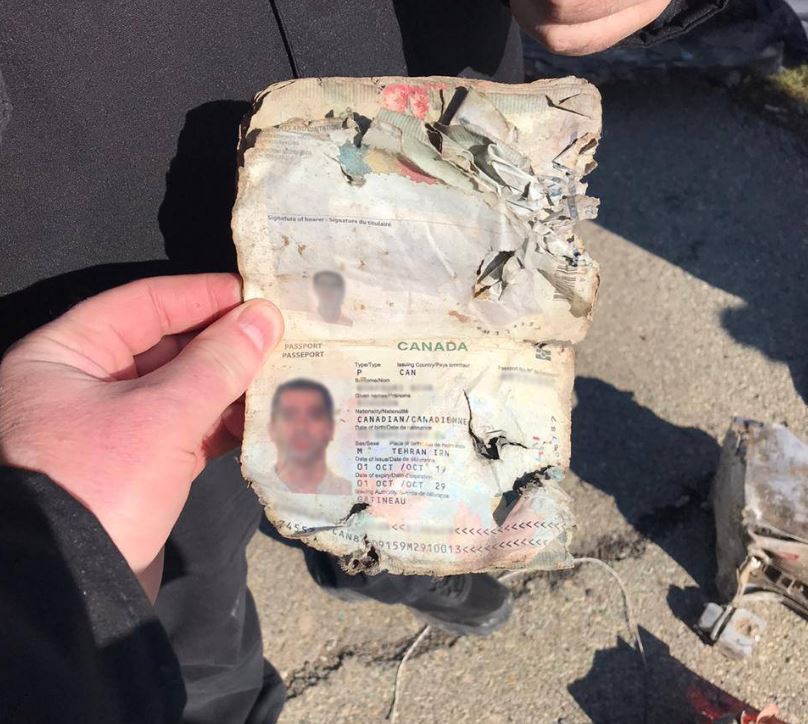 Canadian Passport. Image: Office of the President of Ukraine.
Canadian Passport. Image: Office of the President of Ukraine.
One does wonder why 138 people would travel from Tehran to Canada via Kyiv, but that is only one of many questions associated with this crash. Stranger still are the memorial programs for the Canadian victims that showed up in the media ON THE SAME DAY as the crash. Two that appeared immediately were produced by the CBC and the Vancouver Sun.
The CBC video, “Flight 752: A Canadian Tragedy,” is 45 minutes long and includes extensive reporting, dramatic commentary, and footage of the crash site, as well as the “stories” of the victims, with their full names, biographical information, candid shots, and professional black-and-white photos. The post is now dated January 9, but it was up on January 8. Even considering the time difference between Canada and Iran, it must have taken a cast of thousands working feverishly to compile the information and images and produce the programs so quickly. Unless they had advance notice.
Curiously, relatives and friends of the victims appear in the memorials, some looking barely distressed and even smiling, speaking to reporters ON THE SAME DAY their loved ones died, instead of choosing to grieve in private. One thinks of the cheerful interview of Chris and Lynn McDonnell by Anderson Cooper right after their daughter Grace was supposedly killed at Sandy Hook Elementary by Adam Lanza.
The crash site is also problematic. Debris is strewn over a wide area, with little of it burned. Very few parts of the plane are visible in the news footage, although most of it should have been recovered. The Boeing 737-800 has between 162 and 189 seats, but not a single airplane seat is seen in the footage.
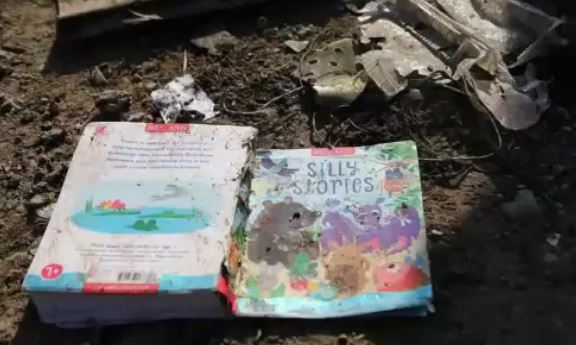
A few pieces of luggage show up, but nowhere near the amount there should be, and papers, water bottles, photo albums, and children’s books survived. And we do have shoes, lots of single shoes – the hallmark of hoax events worldwide.
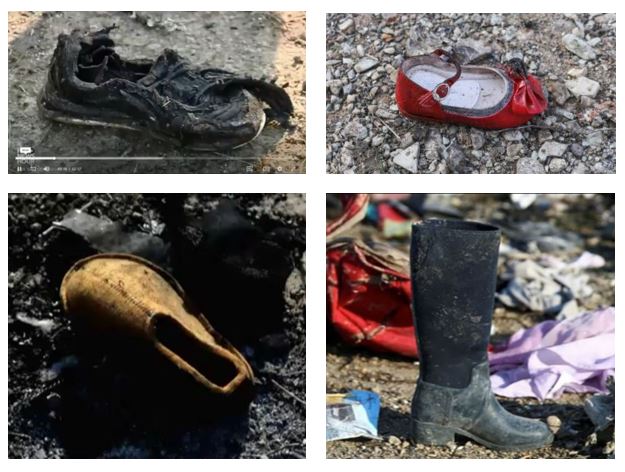
Pieces of debris look dropped at the site, and where they are close to a wall, the wall is not damaged.
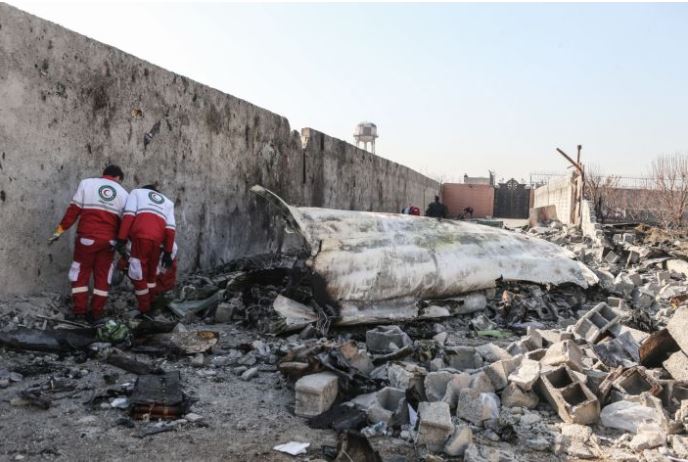
The tail usually survives in a plane crash, but only the tip shows up here, and it looks like it was set down carefully in a tilled field, with the rows undamaged by any kind of impact.
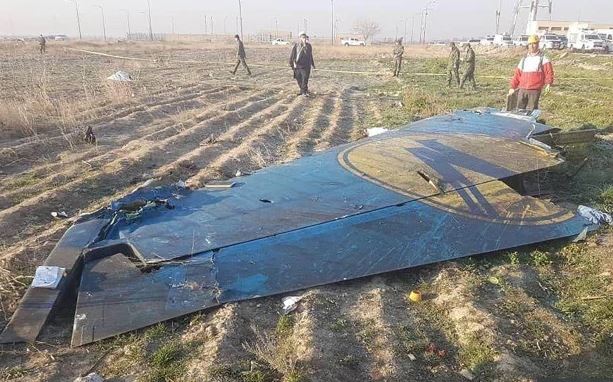
The theory that the plane was shot down by a missile (or two missiles), which supposedly exploded before actually hitting it, is said to be substantiated by a missile part found at the crash site. This is allegedly a piece of a Tor-M1 missile, found in the yard of a home in the city of Parand, although this is unverified.
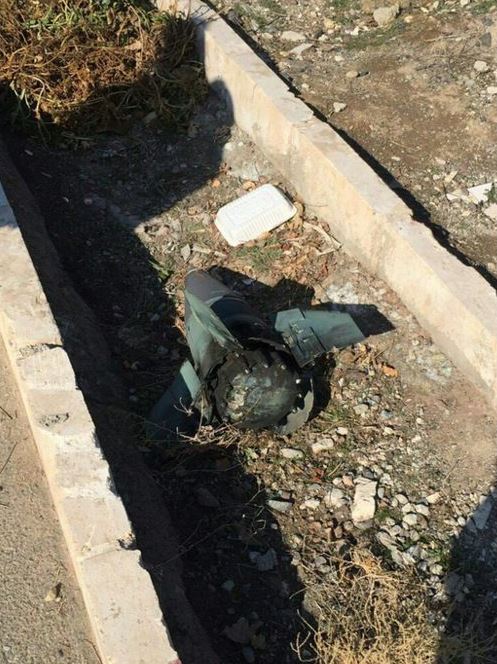 Photo of a Tor-M1 missile part that was posted on Twitter. Image: New York Post.
Photo of a Tor-M1 missile part that was posted on Twitter. Image: New York Post.
It seems that a missile may have been involved, although not to shoot down the airplane. This was discovered by Jeffersonian Girl who has posted several videos on the crash at 153news.net. She is an expert on jet fuel and a designer of fuel farms for airports. The Boeing 737-800 uses Jet A fuel, WHICH DOES NOT EXPLODE. The plane would have broken apart on impact, and fires may have resulted, although the high flashpoint of jet fuel reduces the potential for a post-crash fire. But the plane would not have exploded in a massive fireball.
One of the “amateur” videos, the “third video” posted above, allegedly shows the plane coming in from the right on a straight downward trajectory, hitting the ground in an exploding burst of light. If this video is real, it actually shows a missile and not a Boeing 737. The CCTV video, if real, further indicates that a missile hit the ground and not flight #752. This is all made clear in Jeffersonian Girl’s informative presentation.
None of the “amateur” videos can be assumed to be authentic, just as the stories in the media cannot be trusted. Taken together, however, the evidence points not to a plane crash but to a fake event, perhaps involving a missile, with loads of debris trucked in and deposited for the cameras.
This is further indicated by the lack of a proper investigation of the crash site and the hasty clean-up, which has been blamed on Iran. What about all those people walking around the area and gathering things up, and what about all the body bags? News footage shows many of these bags being carried away from the scene and, in a few cases, being filled with items picked up off the ground. Some of these people are not even in uniform, while others are from the Iranian Red Crescent, an NGO under the aegis of the International Red Cross. As with other deep-state events, local officials are involved, and the cover-up is part of the operation.
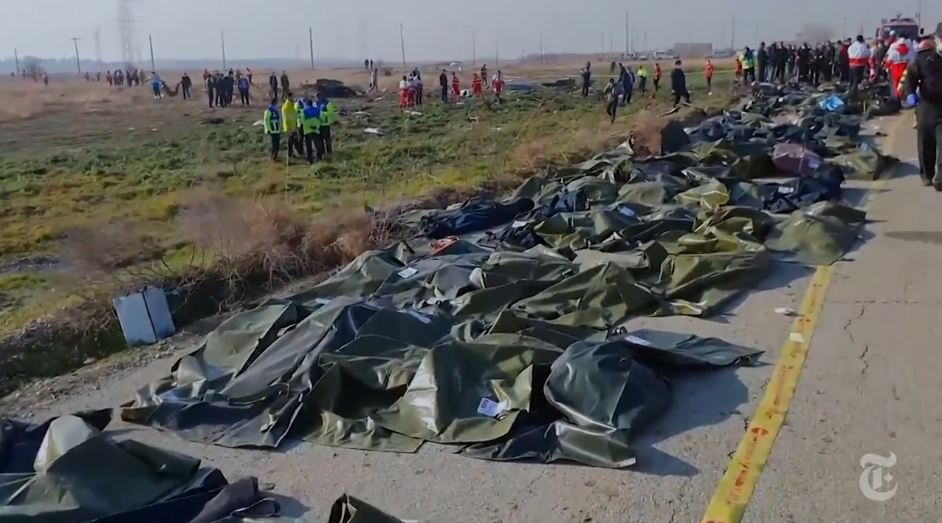 Body bags at the site of the crash of flight #752, filled with junk from the debris field. Image: New York Times.
Body bags at the site of the crash of flight #752, filled with junk from the debris field. Image: New York Times.
Officials in the U.S., Canada, and elsewhere suggested that the Iranians had shot down the plane, although they conceded that it may have been accidental. Iran said that this was “a big lie,” “psychological warfare,” and “scientifically impossible.” After holding out for three days, however, the Iranians knuckled under and took responsibility, admitting that they had shot down the jet by accident. Iranian Foreign Minister Mohammad Javad Zarif apologized in a tweet.
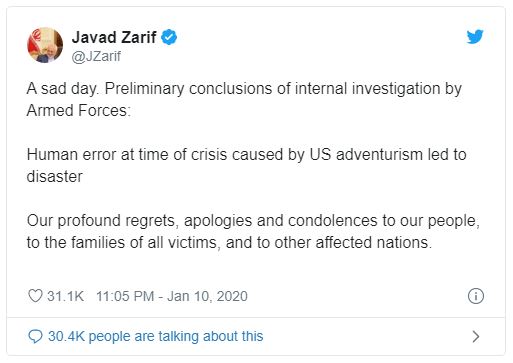
The admission gave rise to protests against the government, with shouts of “Khamenei is a murderer!” as reported by The New York Times. On January 13, The Times was reporting that “at least several people had been shot in the back by security forces, according to witnesses and videos.” Since one cannot believe anything that appears in The Times, it is unclear if this is true. But it further demonizes Iran, and it makes a good story.
So Iran has allegedly shot down a plane full of civilians, killing 176, and is murdering its own people in the streets. And all this stemmed from Trump’s drone strike on Qasem Soleimani on January 3, according to the media. The neocons are pleased, with Iran diminished and on the defensive, with Soleimani dead, and with Trump cast as the culprit. But was Trump really the main instigator?
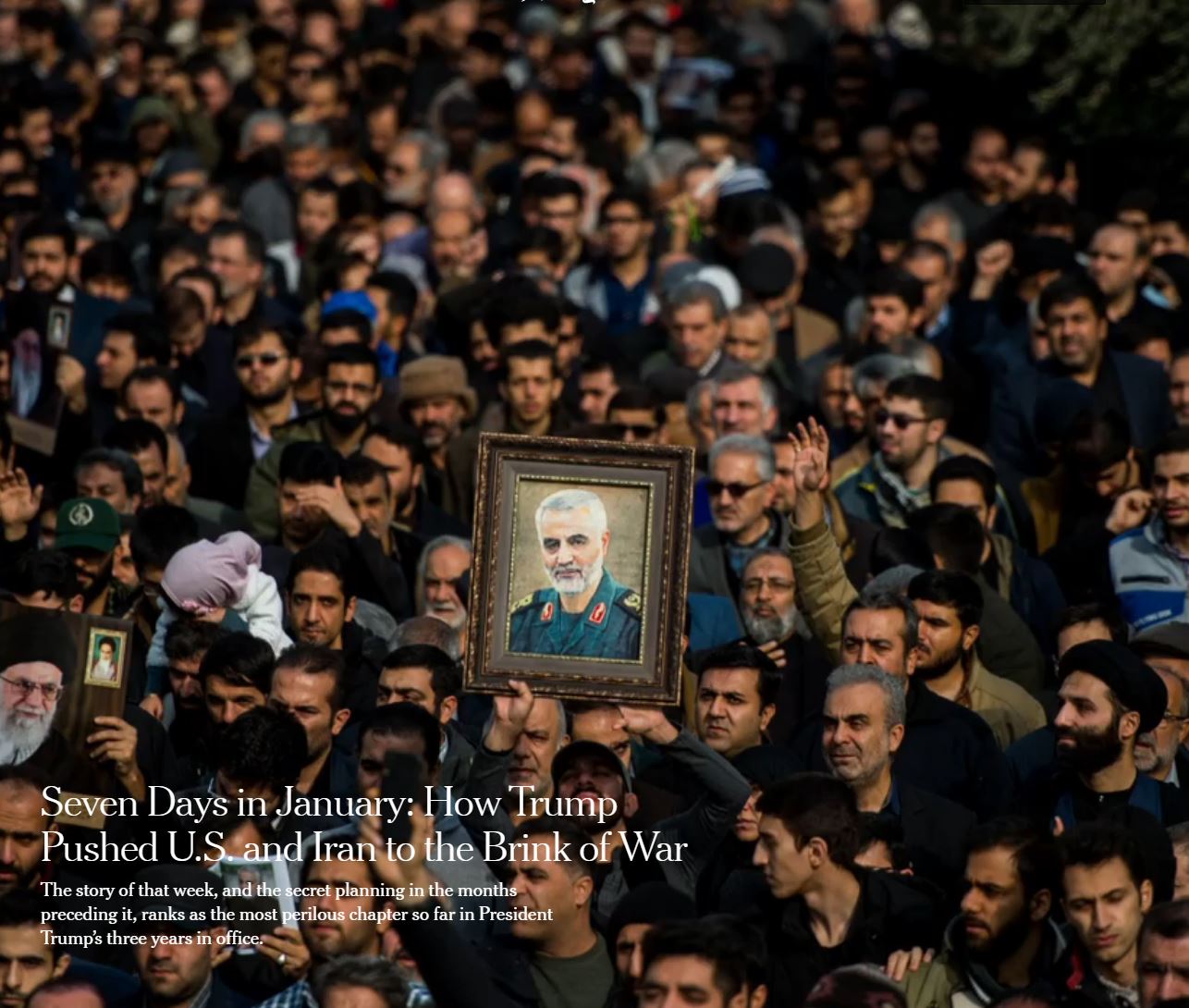
In a two-page spread on Sunday, January 12, The Times published a story claiming that he was indeed at fault: “Seven Days in January: How Trump Pushed U.S. and Iran to the Brink of War.” This is an amusing title, referring to “Seven Days in May,” a 1964 film (based on a 1962 book) about a planned takeover of the U.S. government by a military/political cabal displeased with the fictional President’s disarmament treaty with the U.S.S.R. – that is, with the President’s wish to avoid war and commit to disarmament instead.
That is pretty much what is happening now, with Trump wanting to end the endless wars, and the neocons and their sponsors – Israel chief among them – hoping to keep the wars going and finish up by attacking Iran. The list of authors of “Seven Days in January” reads like a Who’s Who of CIA journalists:

One should remember that Soleimani has been in the sights of Israel and its operatives for years. He was instrumental in Iran’s support for Hezbollah in 2006, and he reportedly worked with Hezbollah in 2010 to strike at Israel. In 2015, Barack Obama allegedly warned Soleimani about an assassination plot by Israel, although by 2018, Israel was supposedly given “the green light” by U.S. officials. Benjamin Netanyahu has campaigned tirelessly for war against Iran, on the pretext that it is developing nuclear weapons.
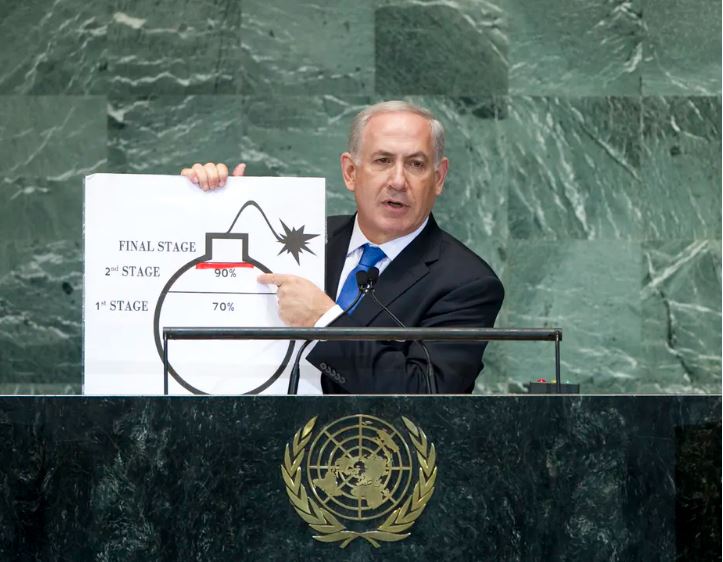 Netanyahu at the UN in 2012, telling the General Assembly that Iran was close to building a nuclear bomb.
Netanyahu at the UN in 2012, telling the General Assembly that Iran was close to building a nuclear bomb.
Although Netanyahu has distanced himself from the assassination of Soleimani, calling it “an American event,” Israeli sources are reporting that “the Jewish state was involved in the January 3 operation, handing the Americans key intelligence details.” The Times reports that Mike Pompeo briefed Netanyahu in advance about the plan to kill Soleimani, and that he was the only non-U.S. leader who knew about it beforehand. Some have speculated that the assassination was carried out by the CIA and Mossad. Did Trump really give the order?
This brings us back to the crash of flight #752. If this was a staged event and not a real plane crash, which is all but certain, who was capable of carrying out such a huge operation – and who benefits? According to the media, we are now very close to a war with Iran. General Hossein Salami, commander-in-chief of the Iranian Revolutionary Guards, apologized for the downing of the jet but added, “We are at war with the United States. We do not consider the conflict over.” The U.S. does not benefit from a war with Iran – nor does Trump, as this would only alienate his supporters and add to his current problems. His defeat in 2020 is already being predicted by the media, due to the situation in Iran.
But one country does benefit from the assassination of Soleimani and the staged plane crash, and that is Israel. While one might think that the crash of a Boeing 737 and the deaths of 176 passengers would be impossible to fake, one should remember the attacks of 9/11. Four passenger planes were said to have crashed into WTC 1 and 2, the Pentagon, and the ground at Shanksville, killing the crews and passengers – although none of this actually happened. The false-flag attacks of 9/11 were engineered by Israel and its accomplices, including many traitors in the U.S. government. Like those attacks, the crash of flight #752 was an orchestrated event on a grand scale, involving an airplane and killing no passengers – calculated to keep America fighting for the Zionist Project.
So what induced the Iranians to take responsibility for downing the Ukrainian jet, when they knew the crash was “scientifically impossible”? As the media saying goes, the situation is still developing.
Vivian Lee is the nom-de-plume of a tenured professor at an east coast university.



No comments:
Post a Comment
Note: only a member of this blog may post a comment.